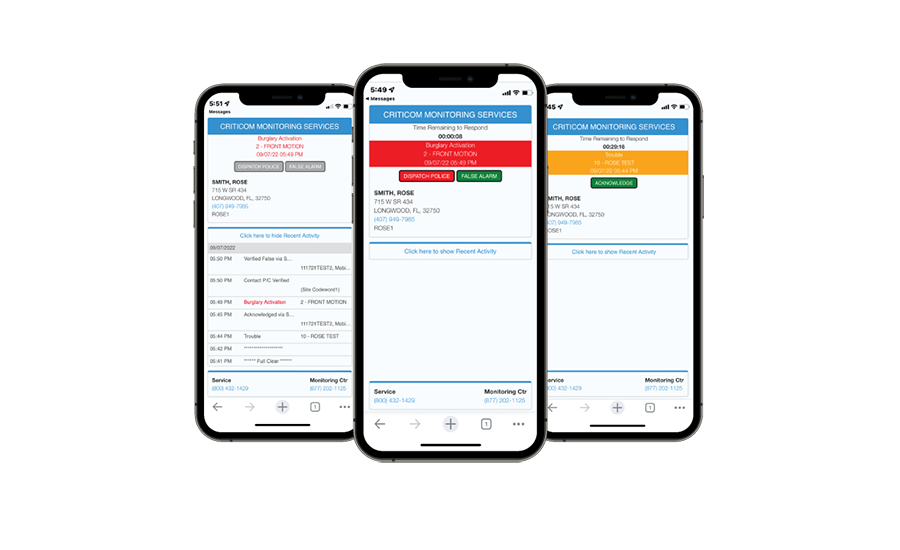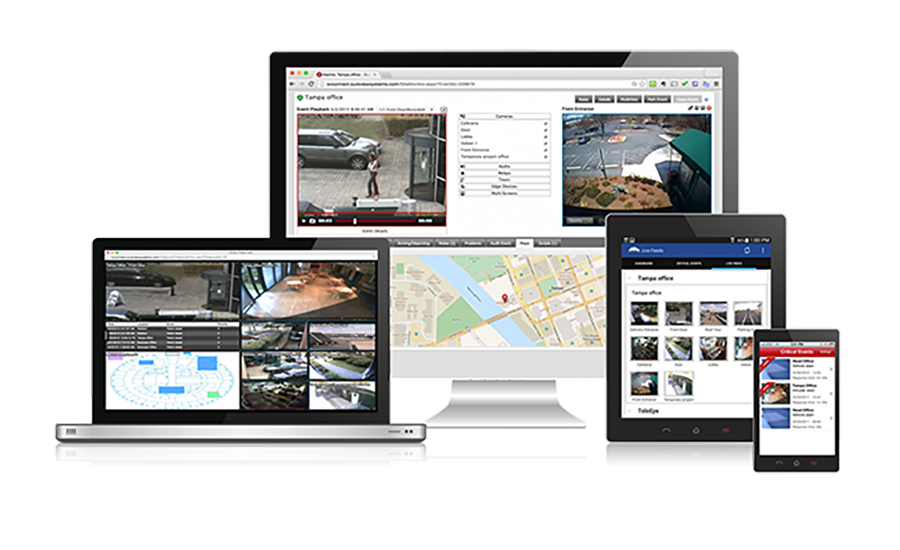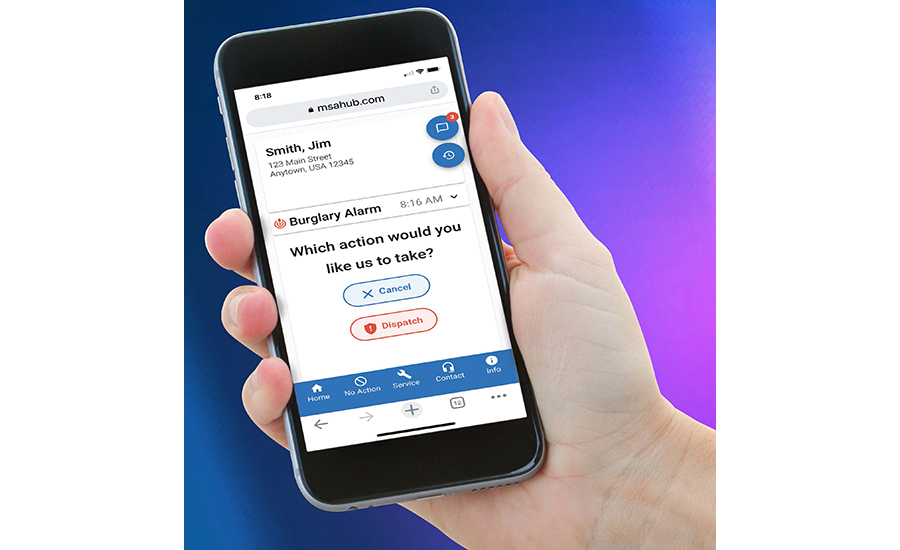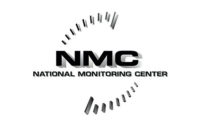What’s new in wholesale central station monitoring? We checked in with several third-party central stations to ask about this.
Some common threads were increased integration, more emphasis on the end user experience, and a continuing effort to reduce false alarms.
Here’s what several of the wholesale central stations told us.
American Two-Way (ATW)
ATW is excited about a new end user instant text notification service it introduced in the spring, which is a direct response to how people receive and respond to critical information, says CEO Christopher Baskin.
Traditionally when a central station receives an alarm, it’s verified by the central station calling the premises and responsible parties. “But the problem today is because with all the spam and robocalls, people aren’t answering their cell phones. … So if the central station tries to call and the party doesn’t answer, a dispatch can occur, producing a false alarm,” he says.
ATW’s new service, which works on any burglar alarm panel, sends end users an instant text notification that the central station has received a burglar alarm in a specific zone, enabling the end user to immediately cancel the alarm directly through the text.
Because the center has already received the signal, there is no delay in the alarm response; the text goes out to the end user within seconds, and the center will wait 45 seconds for the end user to cancel or request a callback before the signal drops to an operator, who handles it like any other signal.
For central stations, this reduces traffic and the amount of callbacks by 10 percent or more, Baskin says. Dealers benefit because they can provide end users with an additional service at no cost to themselves; and the end user reduces false alarms and receives a service they can respond to without having to answer their phone, he says.
“This is the type of service central stations and the industry need to embrace as consumer expectations and how they interact with our services change,” he adds.
Because cloud will play a significant role in the future of central stations, ATW is also continually developing its cloud infrastructure to enhance redundancies, speeds and reliability, Baskin says. This includes continued development of capabilities for remote operators. During the worst of the pandemic, ATW took 50 percent of its operators remote, which showed them the solution works.
“Whether you’re building it out yourself or getting support from an automation company, we see where cloud infrastructure, like in many other industries, will play a big role, and we’re looking to get ahead of that,” he adds.
Also over the past year, ATW introduced a new mobile PERS app and continues to roll out remote patient monitoring and health care solutions, something the company has been doing for years.

Because many phone calls to end users go unanswered, more monitoring centers are turning to SMS text notifications to provide event information. Pictured is Criticom Monitoring Services’ CMS Compass portal to help dealers to track end-user interactions and contact with the monitoring center. // IMAGE COURTESY OF CRITICOM MONITORING SERVICES
Criticom Monitoring Services (CMS)
CMS’ focus is on improving customer contact and providing tools to help reduce attrition, says President Tony Wilson. Because about two-thirds of the calls placed by the company’s monitoring representatives go unanswered by end users, their software developers have added features to the CMS Compass portal to help dealers track end-user interactions and contact with the monitoring center. Additionally, CMS’ business development team works closely with its dealers to provide best practices for increasing customer contact.
The company recently added the option for end users to receive alarm notifications via SMS text message or email notification. “SMS text notifications and CMS’s cancel/verify alarm feature have revolutionized the way end users are engaging with the monitoring center,” Wilson says. Text messages are sent via a “short code” rather than a 10-digit phone number, which provides guaranteed delivery and ensures that end users are notified on alarms whether or not they answer their phone.
These notifications are sent without delay as CMS receives the alarm signal so end users can view recent activity, cancel false alarms or request dispatch from their mobile device without having to call the monitoring center. “We believe subscribers who are engaged with their monitoring center are happy subscribers,” Wilson adds.
CMS has also completely revamped its video offerings, most recently by integrating with CHeKT Video. CMS’s operations team is working on an initiative to help dealers assist end users who were using outdated DVR/NVRs to transition to the CHeKT platform. This integration enhances the user experience for end users, streamlines the video alarm process for CMS monitoring representatives and helps to reduce false alarms.
The CMS operations team is also integrating its MASterMind monitoring software to a platform that will allow the company to communicate with the authorities via Next Generation 911 (NG911) technology. Deployment is expected by Q1 2023.
Finally, CMS’ monitoring team is now trained to offer basic technical support to its tier one end users. CMS dealers using its message center answering service can offer this service to customers, including assistance with arming or disarming an alarm system, silencing an alarm system or fulfilling a request to bypass a zone on an alarm system.
To personalize the experience for customers, CMS dealers can customize the MyAlarms.com customer portal with their logo. The site provides multiple benefits, including alarm notifications via SMS text message or email, the ability to place accounts on/off test without calling the center, and managing multiple sites with a tool that allows users to change the time of the next expected open/close event without calling the monitoring center — all on a single dashboard.
COPS Monitoring
In the past year, COPS Monitoring announced a new partnership with SecureNet Technologies to give dealers the ability to meet the demand for professionally monitored smart home and security services, says Jim McMullen, COPS president. The program provides dealers with access to a service offering that includes smart home interactive services, security and video, bundled with professional monitoring at $5.99 per month per account. Dealers can visit copsmonitoring.com/SNbundle for more information.
To capitalize on growing demand, COPS also added two solutions to its OmniView verified video offerings. The first is Alarm.com’s Visual Verification services. With this integration, Alarm.com-compatible cameras can be programmed to allow COPS dispatchers to view activity prior to dispatch. The second integration is with Immix, a platform that supports a wide range of cameras and NVRs from the industry’s leading manufacturers. Both verified video offerings give operators the ability to more quickly and accurately assess situations and determine if emergency dispatch is required, and provide COPS dealers with access to new revenue from existing customers.
In the coming weeks, COPS will be launching MPower 2.0. MPower is a proprietary dealer access and account management system built for COPS dealers. MPower 2.0 is completely reimagined, with a new responsive interface that works on all connected devices and offers new tools to help return dealers’ time so they can realize their full potential.
Emergency 24 (EM24)
EM24 rolled out several new products and services in 2022 for dealers and their customers. The company integrated with Honeywell’s Connected Life Safety Services (CLSS) Premium, an all-in-one cloud platform for fire safety service, which will enable automatic and electronic transmission of dispatching information into the public safety answering points (PSAP). EM24’s developers and engineers collaborated on the beta development and testing with Honeywell and RapidSOS software development teams to offer the solution.
The company also developed PSAP services, a municipal-monitoring market in which the UL-listed central station receives all fire alarm signals from a jurisdiction, handles the issues and supervisories based on authority having jurisdiction (AHJ) preferences, and sends an automatic digital dispatch with critical information to the local PSAP. This program has been deployed for seven years in several communities in the Chicago area that passed ordinances requiring a single source for commercial fire alarm signal management. PSAP services rely on key partnerships with local fire officials, alarm contractors and the PSAP. A central component of the UL-approved program is a Keltron mesh network and Keltron’s LS7000 Alarm Management System.
EM24 supports Rath Two-Way Visual Communication devices that meet the standards for ASME A17.1/CSA B44 2019, Section 2.27.1, which was established to help people with speaking or hearing impairments. By supporting this capability, the company’s alarm contractors can compete for the monitoring of any elevator in the U.S., opening more opportunities as POTS goes away, and building owners increasingly invest in elevator upgrades and to meet ADA requirements.
The company also supports the CHeKT platform, which works with any ONVIF-compliant camera — a good choice for retrofits and new installations.
EM24 offers expanded reporting capabilities through Visual Point Identification (VPI). In an event, EM24 makes the dispatch and voice notification calls. Decision-makers and emergency responders receive an immediate text with a link to an incident command portal, where they can access a map of the facility, indicating the location of the activation point. Cameras in the facility can be accessed via this interactive floor plan. The system is a critical tool enabling users to learn what is happening in the moment.

Most wholesale monitoring companies are realizing the benefits of integrating with partners to deliver enhanced services to customers. Pictured is an array of monitors at Immix. // IMAGE COURTESY OF IMMIX
Immix
Although the company’s approach hasn’t changed over the past year, CEO Chris Brown has noted a marked emphasis in the industry on how to reduce labor costs and time related to managing each alarm event — especially difficult in an environment where hiring and retaining employees is tougher than ever. “The challenge is finding and hiring a sustainable labor force that wants to work in the office, as well as addressing the high cost of training and turnover,” he says.
To help the company retain its focus, Immix made three key hires on its leadership team this year: Tina Simolaris, head of global customer success; Mark McCall, head director of global operations; and Erin Bullard, director of partner relations.
Over the past two years, Immix has undertaken to rewrite its entire training program for operators on how to use the Immix platform, streamlining the program to align to new workflows including false alarm reduction. The company is also developing tools to help customers choose an AI provider and reduce traffic coming into the center, which in turn reduces the labor pool, cuts costs and improves margins.
Immix is also bringing to market, through a partnership with Captis Intelligence, a tool that allows operators managing an event in progress to capture a picture through video of the suspect, launch it into Captis integration to access law enforcement records, and immediately determine if the suspect is wanted or has a felony rap sheet, identifying them immediately to the police responding to the event. The tool is aligned with every federal, state and municipal law enforcement database in the country.
Immix is integrating this tool into its workflow and platform so its central stations can source the photos and identify the suspect. “As law enforcement becomes slower to respond because they’re understaffed, giving them more information is critical to helping them feel confident in responding to our industry,” Brown says.
Also over the past year, Immix has increased its focus on integration, linking with AI businesses including Calipsa and Actuate, and dispatch partners.
National Monitoring Center (NMC)
“NMC is a company that focuses on quality and top-tier partnerships and services,” says President Woodie Andrawos. “We have and will always associate ourselves with industry leaders who also value quality and professionalism.”
The company has learned that when both partners prioritize a high level of support for all involved, both brands experience greater success and pride in knowing they are helping build a joint vision and shared values, Andrawos explains.
“Creating and sustaining strong industry partnerships with like-minded businesses that share the same ideals and grow with your organization over time results in increased value and higher levels of service and support delivered to all parties,” he adds.
Over the last year, NMC has solidified this approach by partnering with key organizations to deliver secure and trusted alarm response technology and services to residential and commercial customers.
NMC is working with its sister company, Netwatch, to offer proactive video monitoring (PVM) solutions to its dealers. PVM has been the flagship service of NMC for the past four years and continues to serve as a scalable RMR solution for dealers. The company also offers hybrid solutions for its dealers and central station/alarm operators to provide monitoring to their end users. Additionally, its “two-ring policy” remains in effect for dealers, and after hours on-call technical support is available for end users to provide basic troubleshooting.
The company has expanded its ASAP-to-PSAP program to include 71 out of 110 jurisdictions. Many of these jurisdictions were added within the last two years, and NMC continues to add them as they become available.
The company is also unveiling its new Nexus platform, which will launch at the end of this year. Nexus is a smart platform that will include solutions for dealers like data management and “smart search” and will accommodate numerous business intelligence reports.
“A driving factor in creating this product is recognizing that customers expect a frictionless, positive experience in today’s competitive market,” Andrawos says. “This raises the bar on the need to deliver solutions and services to build and retain customer loyalty for brands. At the same time, businesses must also cultivate interest from new contacts looking for a company they know will support them. Excellent customer support and continued innovation can influence customer pricing, allowing organizations to rise above the competition by offering a superior customer experience. We believe the Nexus platform will offer just that.”
NMC is also working on services like Alarm on Test, which is a way for dealers and end users to quickly put accounts on test ad-hoc or using the scheduling service. The company also offers Alarm Account SMS, an app that enables end users to receive immediate alarm notification and quickly verify the alarm and either cancel or dispatch, as well as chat with other key contacts within the account.
“Alarm Account SMS is proving to be a success among our dealers and end users and empowers end users to have that convenient, frictionless experience,” Andrawos says. “No longer do end users have to wait for a phone call to disable a police dispatch or discuss false alarms; it's now all immediate and handled with the swipe of a finger.”
To better tap into an underserved market, NMC has also integrated with organizations including Ajax Systems, which offers innovative and simplified DIY alarm equipment, and RSPNDR, a nationwide network of on-demand guards.
Finally, NMC is in the process of developing its online training academy for its dealers and customers, a streamlined way for them to receive training on NMC products, services and applications. The program will be available by the end of this year and the company will continue to update it as products and services are added to its portfolio.

Rapid Response’s rapidSMS app-free solution is designed to reduce dispatches by over 40 percent. The company has also enhanced its mobile and web apps to make them easier to navigate. // IMAGE COURTESY OF RAPID RESPONSE
Rapid Response Monitoring Services
Over the past two years, Rapid Response increased development of new products and services, and more than doubled its number of employees in IT and software development “in order to produce the most amazing applications you have ever seen,” says Morgan Hertel, vice president of technology and innovation. This includes its rapidSMS app-free solution, designed to reduce dispatches by over 40 percent, and enhancement of its mobile and web apps to make them easier to navigate. Additionally, Rapid Response added more than 50 reporting options and will soon release a suite of customizable dashboards.
Rapid Response continues to enhance and deploy its hosted monitoring platform for either full time or hybrid coverages. The company has also doubled down on its commitment to keep monitoring center personnel inside its UL-listed hardened facilities rather than working remotely.
The company continues to grow its video offerings with dozens of options and supporting more than 300 different kinds of equipment to date. Hosted CSaaS services have also increased dramatically, with more features and reporting added all the time.
Rapid Response continues to keep pace with ASAP-to-PSAP and typically goes online immediately with new PSAPs as they are activated. There are approximately 117 online PSAPs nationally.
Rapid Response also launched its RAPID Identity Protection offering, designed to protect customers from every kind of identity theft. The program is underwritten and managed by Allstate Insurance, and is available for sale to customers by Rapid Response dealers.
In terms of new technology, Rapid Response has developed a “dynamic workflow” into its automation platform. This custom-engineered solution enables the company to take virtually any kind of input such as distance, time, temperature, pressure, crime rates or weather and set up rules to vary the workflow based in these inputs.
For example, the service can examine who is at a home in real time and when they may have left. When Rapid Response receives an alarm from a home, they look to see that status. A disparate system informs Rapid Response that the homeowner, who is normally third on the call list, just arrived at home, so instead of calling the premises and call list, Rapid Response changes the workflow in real time and calls the homeowner on their cell phone. This not only saves time, but provides a higher level of protection for the end user and a better customer experience.
Also this year, Rapid Response launched its new Customer Care Center in Henderson, Nev. Staff at this center focus exclusively on monitoring and customer support. “The Las Vegas area is a good place to hire the kind of people we need,” Hertel says. “We’re excited that the new center is growing very quickly and it is already operational 24/7.”
Stanley Security
Since 1972, Stanley Security has been a leader in wholesale central station monitoring services offering customized solutions to independent alarm dealers with a personalized approach. With two UL/FM certified, hot redundant stations in Washington and Tennessee, Stanley provides monitoring and services to independent alarm dealers across the United States, Puerto Rico and Canada.
With an emphasis on long-term dealer investment, the company utilizes best-in-class technology and value-added programs to suit all phases of a dealer's businesses life cycle.
The company is currently beta testing several products, including an interactive video monitoring system, CLSS by Honeywell, Customer Desk and Alarm Manager, and is continually working to expand into the new areas that offer ASAP-to-PSAP.
Stanley updated its dealer app and website, MASmobile and MASweb, as well as a “long form” so dealers can easily add new accounts and make edits to accounts directly into our system.
The company has also expanded its client relations team to better provide the personal support of its dealers, and plan to begin offering quarterly CEU classes for dealers by the end of this year.




